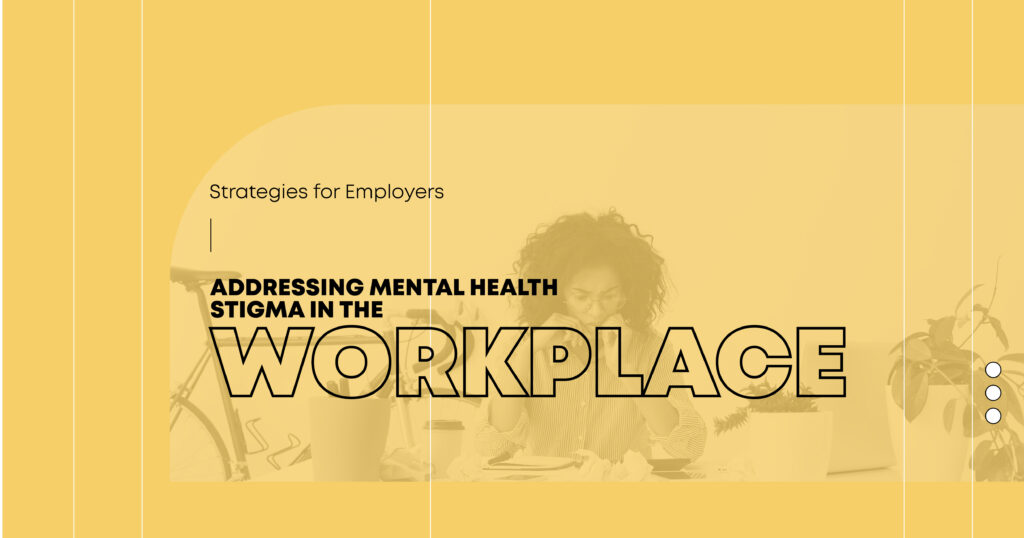Addressing Mental Health Stigma in the Workplace – Strategies for Employers
Mental Health is a Fundamental Part of Every Workplace
In today’s fast-paced world, the workplace is changing to become an inclusive and supportive environment. However, mental health is one of the overlooked areas. Mental health is just as important as physical health and affects an employee’s ability to perform, engage, and contribute to the company’s success. Mental health stigma in the workplace becomes a barrier that affects the employee’s motivation towards seeking help, affecting their well-being and productivity in the workplace. It is essential to eliminate the stigma when working toward creating a comfortable environment and supporting its workforce.
Mental health conditions have been ranked as one of the primary causes of work disability in most research works around the world. Of all the disorders, depression and anxiety lead to the list of disabilities within the workplace. With the increased awareness given to mental health, stigma in the workplace remains an issue to be addressed since employees remain unable to speak out about problems or seek assistance. Employers are responsible for a culture where the mind is valued as much as the body to help and benefit the individual and organization.
Shine Mental Health
What Is Mental Health Stigma?
Mental health stigma refers to the situation where people with mental illness are judged and misconstrued. Stigma might be in the form of judgment, discrimination, and fear of ostracism. Many employees refrain from seeking help because they do not want to be termed weak, unreliable, or incapable of performing jobs. Such an environment fosters hidden suffering, and therefore, worsening the conditions will affect morale at work.
Mental health stigma in the workplace is harmful to both the individual and the entire organization. Employees tend to become stressed, burned out, or even disengaged from their roles if they believe that their mental health problems are not being understood and respected. The destruction of such barriers will play an essential role in bringing out a healthier, productive workplace environment.
Where Does Mental Health Stigma Come From?
Mental health stigma can be attributed to the long period that society has been living with misconceptions. To start with, the understanding of mental illness history is very long. This is something that has been avoided in human history for many centuries. Mental issues have been put down for many years and are considered something people should live with in silence. Today, mental health issues have come to the workplace through being stigmatized like any other personal frailty, instead of being stigmatized as a health issue.
Many workers and their managers know little or nothing about these conditions. This leads to fear and misconceptions. For example, a depressed employee is described as lazy or demotivated instead of somebody with a medical illness. This belief and attitude give way to mental health stigma in the workplace, and it is hard to make people open up and talk about their need for help.
Additionally, workplace culture is strongly driving the perpetuation and reduction of stigma. If performance and productivity have come to represent the highest priorities in an organization, workers tend to perceive reporting mental health difficulties makes them appear vulnerable or vulnerable. This is specifically widespread in the most competitive industries because people tend to fear that openly talking about their mental health jeopardizes future career prospects.
Ways to Encourage Employees to Seek Support
Creating a workplace that makes employees feel safe coming forward and asking for mental health support is not easy. Employers can help break all the barriers that have been constructed, and help individuals reach out when they need help. Here are few strategies for encouraging employees to seek the kind of support they need in the workplace.
Create Safe Spaces for Conversations |
To work on the stigma, a proper ambiance should be set at work where all are comfortable discussing their mental health. Open discussion without fear is the need of the hour to decrease all concerns and give proper understanding. Start with a forum on mental health by engaging in seminars, workshops, and informal conversations to normalize the concept. When management supports mental health, employees would not mind sharing their struggles with them. |
Provide Accessible Mental Health Resources |
Inform your employees that they have mental health services right at their fingertips, be it EAP, counseling services, or mental health days. If they can easily access mental health services at the moment of need, that will really make all the difference in how open they are to action. |
Normalize Mental Health Discussions |
Mental well-being is just as important as physical fitness. Provide regular meetings, even managerial-level meetings, for workers so they can open up about their issues freely without criticism. This not only minimizes the attached stigma but also creates an effective environment where employees are even better empowered to seek what they wish. |
Lead by Example |
Managers and executives need to lead from the front on mental health. Discussing their experiences regarding mental health and showing vulnerability helps the entire leadership set a precedent for the organization. When leaders openly address mental health issues, employees will likely do the same. |
Shine Mental Health
How to Reduce Mental Health Stigma in the Workplace
Reducing mental health stigma in the workplace requires a multi-faceted approach. It includes education, policy changes, and changing the workplace culture. Here are some strategies that employers can undertake to reduce stigma:

Start Conversations About Mental Health
Starting conversations around mental health stigma in the workplace would require ending the silence over mental health-related problems and showing that it’s okay to open up to other employees. Provide an atmosphere that fosters discussion by conducting company-wide campaigns, providing email information, and organizing wellness programs that present information on mental health. Regular talks on mental health are maintained, and the avenue is used where people are comfortable speaking of their issues without judgment.
Confront Internal Stigma
Even if your organization has a supportive atmosphere, internal stigma may still exist. Employees may feel uncomfortable acknowledging mental health challenges due to personal biases or cultural factors. How to overcome stigma at this level requires ongoing efforts to challenge and change these internalized attitudes. Consider implementing bias training and providing tools for self-reflection that help employees confront their misconceptions about mental health.
Train Managers and Supervisors
Managers are very important in the workplace because they help shape the culture and deal with mental health stigma in the workplace. Managers and supervisors should be trained to identify signs of mental health problems and be responsive with empathy and understanding.
Managers should be trained to recognize changes in behavior or productivity as symptoms of mental health challenges, and learn how to have supportive conversations with their team members. By fostering an open, supportive approach, managers can lead by example and set the tone for inclusivity.
Address the Specific Needs of Marginalized Groups
Some communities, such as those within the Latino culture, present unique challenges to deal with mental health stigma in the workplace. There is a cultural phenomenon where family and community matters often supersede one’s health, and an individual should not seek help if their employer frowns upon it.
Culturally competent programs are available to help overcome mental health stigma in the Latino community. Supporting various kinds of employees will help reduce stigma and create better awareness in the workplace.
What Does It Look Like When a Company Culture Is Open About Mental Health?
It makes it possible for a company culture to become an open place where the employee feels valued, supported, and understood. Here is what it looks like:
- Increased Productivity and Engagement. An employee will be more engaged in their work when they feel supported and understood. A culture around mental health improves the employee’s morale and overall performance.
- Increased Retention Rates. This is because employees will want to stay longer with an organization that is supportive of their mental health journey. They are valued not only as workers but as people.
- Healthy Workplace Relationships. A healthy workplace environment fosters friendship and cooperation among colleagues. The employees are more likely to cooperate and help each other when they know the organization has open discussion and support about mental health.
Standing Up to Stigma
As an employer, you should not just oppose stigma, but actively work to create a more supportive and inclusive environment. Improving mental health stigma in the workplace benefits your employees by ensuring their well-being and also improves productivity.
Advise them to speak up about mental health and offer devices that could help people find a way to handle their conditions to motivate leaders of any department to care more about the development of the psychological aspect of health. Specifically, on matters of eliminating stigma, address stigma in the workplace toward the culture of knowing and helping and prioritizing it on issues of mental health.
Mental Health Stigma in the Workplace & Strategies
Mental health stigma in the workplace cannot be overcome overnight. However, if employers are intentional about breaking down stigma barriers, they can help build a workplace that supports mental health.
Breaking stigma barriers can begin by starting conversations to train management to provide resources. Building thriving, mentally healthy workplaces with collaboration to break the obstacles is possible.

Call to Action:
Act on it today by reviewing your current policies on mental health, setting up conversations about mental health, and training managers to support their teams. Your commitment to breaking the mental health stigma in the workplace can make all the difference in the success and well-being of your company’s employees.
Shine Mental Health
FAQ’s
- What is mental health stigma in the workplace?
Mental health stigma in the workplace refers to negative attitudes and stereotypes about employees who experience mental health challenges, which can result in discrimination or reluctance to seek support.
- How can employers address mental health stigma in the workplace?
Employers can address stigma by creating open conversations about mental health, providing resources, training managers, and fostering a supportive environment that values employee’s well-being.
- What are some strategies for overcoming mental health stigma in the workplace?
Some strategies include encouraging open discussions about mental health, confronting internal biases, offering leadership training, and addressing the needs of marginalized communities, such as the Latino community.
- How does mental health stigma impact employee performance?
Mental health stigma in the workplace can lead to employees feeling isolated, stressed, or hesitant to seek help, resulting in decreased productivity, engagement, and overall job satisfaction.
- What role do managers play in reducing mental health stigma?
Managers can help reduce mental health stigma in the workplace by being supportive, recognizing signs of mental health struggles, and engaging in empathetic conversations with employees, creating an inclusive, non-judgmental environment.







